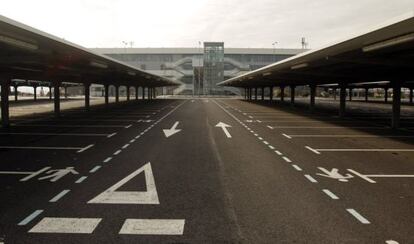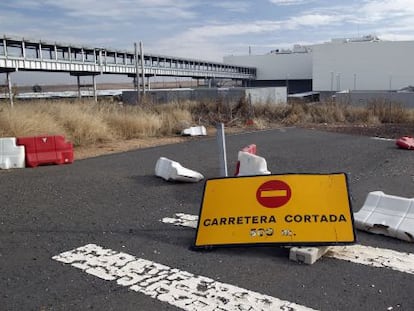How did Spain’s white elephant airport end up with a €10k price tag?
A mystery company put in the only bid for Ciudad Real, which cost €450 million to build


The courtroom was filled with journalists, creditors, business people and just one bidder, who came in the company of several lawyers.
“All right then, €10 million,” said the court clerk.
There was a commotion in the room. José Manuel González Porro, the man behind Tzaneen – the company supposedly backed by Chinese money to buy the airport at Ciudad Real, a provincial capital 160 kilometers south of Madrid, in order to use it as an import base for Chinese goods – had in fact offered €10,000 and not €10 million.
The future of the airport cannot involve anybody who has played a role in its management to date”
Spokesperson for Castilla-La Mancha government
Sources at the auction say that the court-appointed airport administrators, who had been working on the insolvency case for five years, were left speechless.
It was just the latest chapter in a long story that had begun eight years earlier, when a private airport that was going to contribute 8.5 percent to Castilla-La Mancha’s regional GDP instead joined a long list of white elephants built during Spain’s construction boom.
How did things get to the point where a practically brand new, state-of-the-art airport was being sold off for little more than loose change?
The eternally empty bus
Since it opened, just three airlines have operated out of Ciudad Real Central Airport: Vueling, Ryanair and Air Berlin, who were paid with public money (€2.6 billion) in the form of advertising, which is a way of getting round EU competition rules to prevent public subsidies of airlines.
Even when Ciudad Real airport was at its busiest, there were just three flights a week (in total, the airport handled 190,000 passengers), along with light aircraft hired by hunters. Every hour, an empty bus covered the 15 kilometers between Ciudad Real and the airport.
There are still a few employees left at the airport: a director, some maintenance workers, and security staff, although the companies they work for haven’t been paid, and that will only happen if the final offer to buy the airport is large enough to cover that portion of its debt.
“It’s a shame, this airport is truly a wonder,” say sources with ties to the former owners: “Whoever ends up keeping it, even for €28 million, will have made a killing.”
After five years of bankruptcy proceedings and dozens of failed purchase offers, administrators decided to hold an auction with no minimum starting price. The only requirement was that bidders should post a €2 million guarantee deposit. Of three potential bidders who had expressed an interest in the airport, only one, Tzaneen, deposited the money.
On June 18, the day before the auction, the court clerk suspended it on the grounds that the bid now included a last-minute purchase option at preferential prices for the surrounding land (the original sale only included the 520 hectares comprising the runway, the terminal building, the control tower and the car park). The court official felt that this new addition changed the terms of the auction.
“It was a move to gain more time,” says a source involved directly in the matter. The court secretary was charged with breach of public duty after Tzaneen filed a complaint. A month later, a judge decided that suspending the auction had been illegal.
But when he set a new auction date, July 17, he only allowed bidders who had already deposited the guarantee to take part. And that is why Tzaneen – or a man named González Porro – was able to get away with offering just €10,000. In fact, if he had wanted to, he could have offered just one cent.
Who is Tzaneen?
Tzaneen is a limited company that was set up in March with a capital of €4,000 by Porro, who served as executive director and secretary of the insurance company Mapfre until 2011. Porro has refused to talk directly to EL PAÍS. His press agent says that the company is an investment vehicle, but refuses to provide any more information about who exactly, if anyone, has invested in the company.
Although the media originally reported that Chinese investors were behind Tzaneen, this has not been confirmed by the company.
“Right now, all the partners are on business trips, looking for investors,” says the communications officer, refusing to comment on whether there is any Chinese involvement in Tzaneen – which is not a Chinese name, but a reference to a place in South Africa.
What little is known is that while at Mapfre, González Porro worked with Ignacio Barco, a former partner of CR Aeropuertos, the airport operator.
It is also a fact that there are around 200 creditors waiting to be paid almost €200 million in debt, and a company that invested €450 million in the project and is not prepared to lose all of that money. What’s more, the insolvency administration has contracted another €28 million debt in loans to cover maintenance fees over the last five years (and the administrators' fees).
Everybody involved in this strange affair has a lot at stake. But the way things stand, they will all lose out if González Porro’s €10,000 offer is accepted.
But there is another deadline that is offering creditors some hope.
A new offer?
Until September 14, any new buyer who steps in with €28 million (representing 70 percent of the infrastructure's appraisal value of €40 million) gets to keep the airport.
“That’s what the administrators believe is ultimately going to happen, but it’s not clear that it will,” says Jesús Barroso, the lawyer for CR Aeropuertos, the company that still formally owns the airport. Some sources believe that it is, in fact, this company that is behind the entire operation in an attempt to regain control of the facility at a lower price and free of debt.
Sources at the regional government rule this out, saying: “The future of the airport cannot involve anybody who has played a role in its management to date.” The head of the regional government of Castilla-La Mancha, Emiliano García-Page, said last week that he wants to see “investment,” not “speculation”.

The airport cost €450 million to build, of which €170 million was borrowed from regional savings bank Caja Castilla-La Mancha. The idea was that it would become a cargo hub able to compete with Barajas. With no housing under its flight paths, the airport could receive traffic 24 hours a day, and it would move some 2.5 million passengers a year as well as 100,000 tons of cargo.
Construction is high quality, the runway is 4.5 kilometers long, and there are 1,240 hectares of land around it that can be used to build warehouses. It has the latest luggage-management technology, and a state-of-the art fiber optics and copper network worth millions of euros.
Besides that, operators built a connecting path to the AVE high-speed railway, where a station was approved for construction. This would allow passengers to be in Madrid within 50 minutes.
When it was inaugurated in December 2008, around 200 people were working at the airport, although the first plane didn’t land until six months later. It shut down completely in April 2012 after becoming known as a ghost airport.
In Ciudad Real itself, residents are hopeful that a buyer will be found who can get the airport up and running again. Most people say they do not care whether it is the former owners, a Chinese group, or the regional government itself. They want planes back, and with them, the jobs and the money that they were promised. They probably face a long wait.
Tu suscripción se está usando en otro dispositivo
¿Quieres añadir otro usuario a tu suscripción?
Si continúas leyendo en este dispositivo, no se podrá leer en el otro.
FlechaTu suscripción se está usando en otro dispositivo y solo puedes acceder a EL PAÍS desde un dispositivo a la vez.
Si quieres compartir tu cuenta, cambia tu suscripción a la modalidad Premium, así podrás añadir otro usuario. Cada uno accederá con su propia cuenta de email, lo que os permitirá personalizar vuestra experiencia en EL PAÍS.
¿Tienes una suscripción de empresa? Accede aquí para contratar más cuentas.
En el caso de no saber quién está usando tu cuenta, te recomendamos cambiar tu contraseña aquí.
Si decides continuar compartiendo tu cuenta, este mensaje se mostrará en tu dispositivo y en el de la otra persona que está usando tu cuenta de forma indefinida, afectando a tu experiencia de lectura. Puedes consultar aquí los términos y condiciones de la suscripción digital.
More information
Últimas noticias
From Andorra to Gibraltar, a black market for Ozempic exploits its success: ‘They’re the most sought-after products in the world’
From Hungary’s Orbán to Chile’s Kast: How Trump helps turbo charge the far right
Magnets in their heads: How some animals guide themselves using the Earth’s magnetic field
The brief rise and retreat of Generation Z in Mexico
Most viewed
- Why we lost the habit of sleeping in two segments and how that changed our sense of time
- Trump’s obsession with putting his name on everything is unprecedented in the United States
- Charles Dubouloz, mountaineering star, retires at 36 with a farewell tour inspired by Walter Bonatti
- The Florida Keys tourist paradise is besieged by immigration agents: ‘We’ve never seen anything like this’
- Living in a motorhome due to soaring housing prices in Madrid: ‘I got used to it quickly, but I don’t idealize it’









































